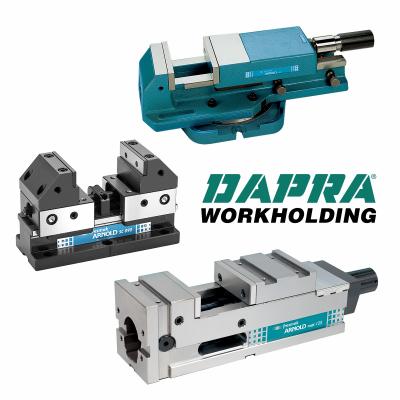
Dapra Corp. offers a full line of Arnold high-pressure vises that provide controllable power and dependable clamping for a variety of workholding applications. The Arnold family of vises, manufactured by world leader Fresmak, includes durable solutions that are suitable for milling, grinding, drilling, toolroom and production work. These vises are manufactured to precision tolerances and accurate standards to ensure reliability and long life, according to the company.
Arnold’s all-purpose Classic Hydravise provides up to 18,000 lbs. of clamping pressure, with jaw widths from 3.5” to 8”. Hydraulic and mechanical spindles are available, as are narrow base configurations for applications requiring close mounting.
Dapra also offers Arnold vises that are for horizontal and vertical machining centers; twin workpiece clamping; and 5-axis machining (featuring tall jaws). Self-centering vises with small footprints are available without high-pressure clamping.
Contact Details
Related Glossary Terms
- gang cutting ( milling)
gang cutting ( milling)
Machining with several cutters mounted on a single arbor, generally for simultaneous cutting.
- grinding
grinding
Machining operation in which material is removed from the workpiece by a powered abrasive wheel, stone, belt, paste, sheet, compound, slurry, etc. Takes various forms: surface grinding (creates flat and/or squared surfaces); cylindrical grinding (for external cylindrical and tapered shapes, fillets, undercuts, etc.); centerless grinding; chamfering; thread and form grinding; tool and cutter grinding; offhand grinding; lapping and polishing (grinding with extremely fine grits to create ultrasmooth surfaces); honing; and disc grinding.
- milling
milling
Machining operation in which metal or other material is removed by applying power to a rotating cutter. In vertical milling, the cutting tool is mounted vertically on the spindle. In horizontal milling, the cutting tool is mounted horizontally, either directly on the spindle or on an arbor. Horizontal milling is further broken down into conventional milling, where the cutter rotates opposite the direction of feed, or “up” into the workpiece; and climb milling, where the cutter rotates in the direction of feed, or “down” into the workpiece. Milling operations include plane or surface milling, endmilling, facemilling, angle milling, form milling and profiling.
